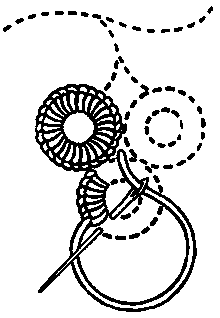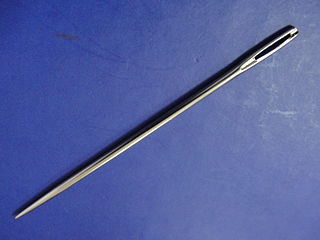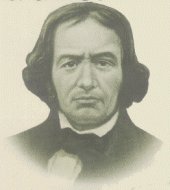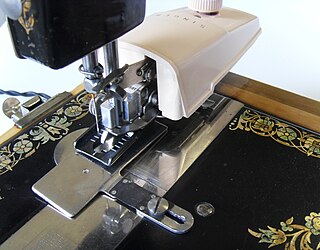

Feed dogs are movable plates which pull fabric through a sewing machine in discrete steps between stitches.


Feed dogs are movable plates which pull fabric through a sewing machine in discrete steps between stitches.
A set of feed dogs typically resembles two or three short, thin metal bars, crosscut with diagonal teeth, which move both front to back and up and down in slots in a sewing machine's needle plate: front to back to advance fabric gripped between the dogs and the presser foot toward the needle, and up and down to recess at the end of their stroke, release the fabric, and remain recessed while returning before emerging again to begin a new one.
This arrangement is called "drop feed" in reference to the way the dogs drop below the needle plate when returning for the next stroke. Allen B. Wilson invented it during the time period 1850 to 1854, [1] [2] while also developing the rotary hook. Wilson called it a "four-motion feed", in reference to the four movements the dogs perform during one full stitch: up into the fabric, back to pull the fabric along to the next stitch, down out of the fabric and below the needle plate, and then forward to return to the starting position.
Virtually all drop-feed sewing machines can vary their stitch length; this is typically controlled by a lever or dial on the front of the machine. They are usually also capable of reversing the feed dogs' motion to pull the fabric backwards to form a backstitch.

A sewing machine is a machine used to sew fabric and materials together with thread. Sewing machines were invented during the first Industrial Revolution to decrease the amount of manual sewing work performed in clothing companies. Since the invention of the first sewing machine, generally considered to have been the work of Englishman Thomas Saint in 1790, the sewing machine has greatly improved the efficiency and productivity of the clothing industry.

A lockstitch is the most common mechanical stitch made by a sewing machine. The term "single needle stitching", often found on dress shirt labels, refers to lockstitch.

Machine embroidery is an embroidery process whereby a sewing machine or embroidery machine is used to create patterns on textiles. It is used commercially in product branding, corporate advertising, and uniform adornment. It is also used in the fashion industry to decorate garments and apparel. Machine embroidery is used by hobbyists and crafters to decorate gifts, clothing, and home decor. Examples include designs on quilts, pillows, and wall hangings.

An overlock is a kind of stitch that sews over the edge of one or two pieces of cloth for edging, hemming, or seaming. Usually an overlock sewing machine will cut the edges of the cloth as they are fed through, though some are made without cutters. The inclusion of automated cutters allows overlock machines to create finished seams easily and quickly. An overlock sewing machine differs from a lockstitch sewing machine in that it uses loopers fed by multiple thread cones rather than a bobbin. Loopers serve to create thread loops that pass from the needle thread to the edges of the fabric so that the edges of the fabric are contained within the seam.

In everyday language, a stitch in the context of embroidery or hand-sewing is defined as the movement of the embroidery needle from the back of the fibre to the front side and back to the back side. The thread stroke on the front side produced by this is also called stitch. In the context of embroidery, an embroidery stitch means one or more stitches that are always executed in the same way, forming a figure. Embroidery stitches are also called stitches for short.

A sewing needle, used for hand-sewing, is a long slender tool with a pointed tip at one end and a hole at the other. The earliest needles were made of bone or wood; modern needles are manufactured from high carbon steel wire and are nickel- or 18K gold-plated for corrosion resistance. High quality embroidery needles are plated with two-thirds platinum and one-third titanium alloy. Traditionally, needles have been kept in needle books or needlecases which have become objects of adornment. Sewing needles may also be kept in an étui, a small box that held needles and other items such as scissors, pencils and tweezers.

Barthélemy Thimonnier was a French inventor, who is attributed with the invention of the first sewing machine that replicated sewing by hand. He was born in L'Arbresle, in Rhône in France.

A stocking frame was a mechanical knitting machine used in the textiles industry. It was invented by William Lee of Calverton near Nottingham in 1589. Its use, known traditionally as framework knitting, was the first major stage in the mechanisation of the textile industry, and played an important part in the early history of the Industrial Revolution. It was adapted to knit cotton and to do ribbing, and by 1800 had been adapted as a lace making machine.

A knitting machine is a device used to create knitted fabrics in a semi or fully automated fashion.

Helen Augusta Blanchard was an American inventor who received 28 patents between 1873 and 1915. She was known for her numerous inventions dealing with sewing machines and sewing technology.

Allen Benjamin Wilson (1823–1888) was an American inventor famous for designing, building and patenting some of the first successful sewing machines. He invented both the vibrating and the rotating shuttle designs which, in turns, dominated all home lockstitch sewing machines. With various partners in the 19th century he manufactured reliable sewing machines using the latter shuttle type.
Wheeler & Wilson was an American company which produced sewing machines. The company was started as a partnership between Allen B. Wilson and Nathaniel Wheeler after Wheeler agreed to help Wilson mass-produce a sewing machine he designed. The two launched their enterprise in the early 1850s, and quickly gained widespread acclamation for their machines' designs. Both Wheeler and Wilson died in the late 19th century, resulting in the company's sale to the Singer Corporation. Shortly after, the Singer Corporation phased out Wheeler & Wilson's designs. The company sold a total of nearly 2,000,000 sewing machines during its existence.

Machine quilting is quilting made using a sewing machine to stitch in rows or patterns using select techniques to stitch through layers of fabric and batting in the manner of old-style hand-quilting. Some machines even replicate hand stitching, for example Sashiko or running stitch quilting.
The Singer Model 27 and later model 127 were a series of lockstitch sewing machines produced by the Singer Manufacturing Company from the 1880s to the 1960s.. They were Singer's first sewing machines to make use of "vibrating shuttle" technology. Millions were produced. They are all steel and cast iron, and were built before the advent of planned obsolescence, and so they were designed to be repaired rather than replaced. Consequently many remain today, some in collections and others still in service. In company literature they were called "the woman's faithful friend the world over".
A zigzag stitch is variant geometry of the lockstitch. It is a back-and-forth stitch used where a straight stitch will not suffice, such as in reinforcing buttonholes, in stitching stretchable fabrics, and in temporarily joining two work pieces edge-to-edge.

A walking foot is a mechanism for feeding the workpiece through a sewing machine as it is being stitched. It is most useful for sewing heavy materials where needle feed is mechanically inadequate, for spongy or cushioned materials where lifting the foot out of contact with the material helps in the feeding action, and for sewing many layers together where a drop feed will cause the lower layers to shift out of position with the upper layers. A walking foot is also good for sewing materials with varying layers because it can climb up and down these layers easier than other feeding mechanisms.

A buttonholer is an attachment for a sewing machine which automates the side-to-side and forwards-and-backwards motions involved in sewing a buttonhole.
The Davis Sewing Machine Company began in 1868 in Watertown, New York, and moved to Dayton, Ohio, around 1890.

A presser foot is an attachment used with sewing machines to hold fabric flat as it is fed through the machine and stitched. Sewing machines have feed dogs in the bed of the machine to provide traction and move the fabric as it is fed through the machine, while the sewer provides extra support for the fabric by guiding it with one hand. A presser foot keeps the fabric flat so that it does not rise and fall with the needle and pucker as it is stitched. When especially thick workpieces are to be sewn, such as quilts, a specialized attachment called a walking foot is often used rather than a presser foot.

The hand embroidery machine is a manually operated embroidery machine. It was widely used in the Swiss embroidery industry during the late nineteenth and early twentieth centuries. It was also used in the lace industry near Plauen, Germany, and it played a role in the development of the embroidery industry centered in Hudson County, New Jersey during the early 20th century.